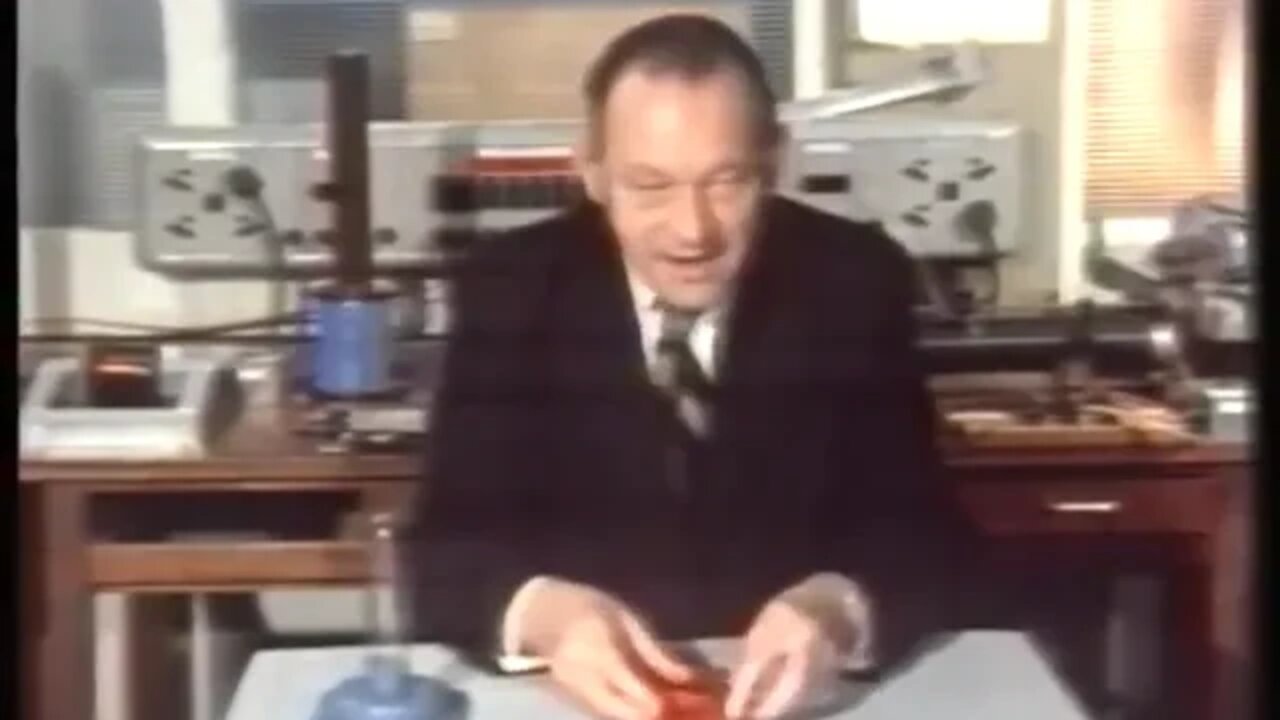Premium Only Content

Professor Eric Laithwaite Demonstrating A Magnetic River 1975
Eric Roberts Laithwaite was born in Atherton, Lancashire, on 14 June 1921, raised in the Fylde, Lancashire and educated at Kirkham Grammar School. He joined the Royal Air Force in 1941. Through his service in World War II, he rose to the rank of Flying Officer, becoming a test engineer for autopilot technology at the Royal Aircraft Establishment in Farnborough.
On demobilization in 1946, he attended the University of Manchester to study electrical engineering. His work on the Manchester Mark I computer earned him his master's degree. His subsequent doctoral work started his interest in linear induction motors. He derived an equation for "goodness" which parametrically describes the efficiency of a motor in general terms, and showed that it tended to imply that large motors are more efficient.[1]
He became professor of heavy electrical engineering at Imperial College London in 1964 where he continued his successful development of the linear motor. He was involved in creating a self-stable magnetic levitation system called Magnetic river which appeared in the film The Spy Who Loved Me where it levitated and propelled a tray along a table to decapitate a seated dummy.
All that remains of the Tracked Hovercraft test system, the RTV 31 test vehicle and a single portion of its guideway preserved at Railworld near Peterborough.
He also worked at applying linear motors on the Tracked Hovercraft until its cancellation.
In the 1980s, he was involved in creating a device to extract energy from sea waves.[2] Although the technology was successful in trials, it could not be made storm proof, so it never became a commercial success.
Laithwaite was an able communicator who made many television appearances. Notable among these were his Royal Institution Christmas Lectures to young people in 1966 and 1974. The latter of these made much of the surprising properties of the gyroscope.
In 1974, Laithwaite was invited by the Royal Institution to give a talk on a subject of his own choosing. He decided to lecture about gyroscopes, a subject in which he had only recently become interested. His interest had been aroused by an amateur inventor named Alex Jones, who contacted Laithwaite about a reactionless propulsion drive he (Jones) had invented.
After seeing a demonstration of Jones's small prototype (a small wagon with a swinging pendulum which advanced intermittently along a table top), Laithwaite became convinced that "he had seen something impossible". In his lecture before the Royal Institution he claimed that gyroscopes weigh less when spinning and, to demonstrate this, he showed that he could lift a spinning gyroscope mounted on the end of a rod easily with one hand but could not do so when the gyroscope was not spinning. This was discussed in the BBC science series 'Horizon - 2015-2016: 2. Project Greenglow - The Quest for Gravity Control'.
In his 1974 lectures, Laithwaite suggested that Newton's laws of motion could not account for the behaviour of gyroscopes and that they could be used as a means of reactionless propulsion.[3] The members of the Royal Institution rejected his ideas and his lectures were not published at the time, a first for the Royal Institution. His lectures were subsequently published independently as Engineer Through The Looking-Glass and also on the Royal Institution website
-
 2:47:04
2:47:04
DDayCobra
4 hours ago $10.29 earnedCharlie Kirk SHOT
59.6K24 -
 LIVE
LIVE
LFA TV
13 hours agoBREAKING: CHARLIE KIRK ASSASSINATED - WEDNESDAY 9/10/25
2,698 watching -
 1:14:30
1:14:30
Redacted News
3 hours agoBREAKING! CHARLIE KIRK SHOT BY ASSASSIN IN UTAH, TRUMP CALLS FOR NATIONAL PRAYERS
197K356 -
 3:50:27
3:50:27
Right Side Broadcasting Network
9 hours agoLIVE REPLAY: Latest News from the Trump White House - 9/10/25
287K85 -
 1:12:05
1:12:05
vivafrei
6 hours agoLegacy Media is the Enemy of the People! Israel Stikes Qatar, U.S., Gets Mad! AOC So Stupid & MORE!
134K75 -
 52:13
52:13
The Quartering
5 hours agoRace War Nears, Russia Makes Huge Mistake, Fauci Bombshell & More
157K86 -
 LIVE
LIVE
Dr Disrespect
8 hours ago🔴LIVE - DR DISRESPECT - THE FINALS - NEW SEASON 8 LAUNCH EVENT W/ THE SHOTTY BOYS
1,068 watching -
 1:44:11
1:44:11
Darkhorse Podcast
6 hours agoWe are waking up, but at a terrible price: The 294th Evolutionary Lens with Bret Weinstein and Heather Heying
141K15 -
 11:49
11:49
Dr. Nick Zyrowski
9 days ago12 Unusual NAC ( N-Acetyl Cysteine) Questions Nobody Ever Answers
153K13 -
 1:03:45
1:03:45
Russell Brand
7 hours agoWW3 IMMINENT! Israel & Russia Strikes Leave World “ON THE BRINK” - SF631
250K75